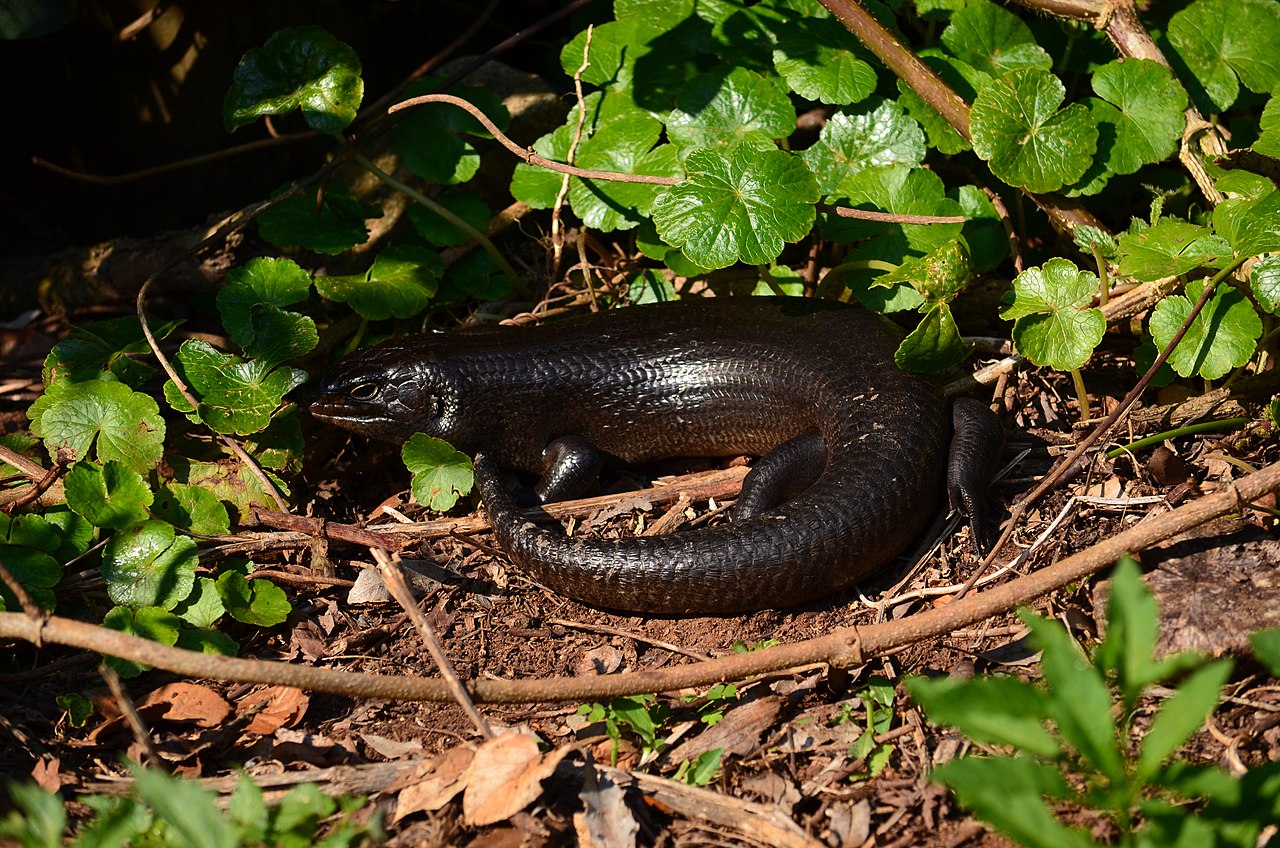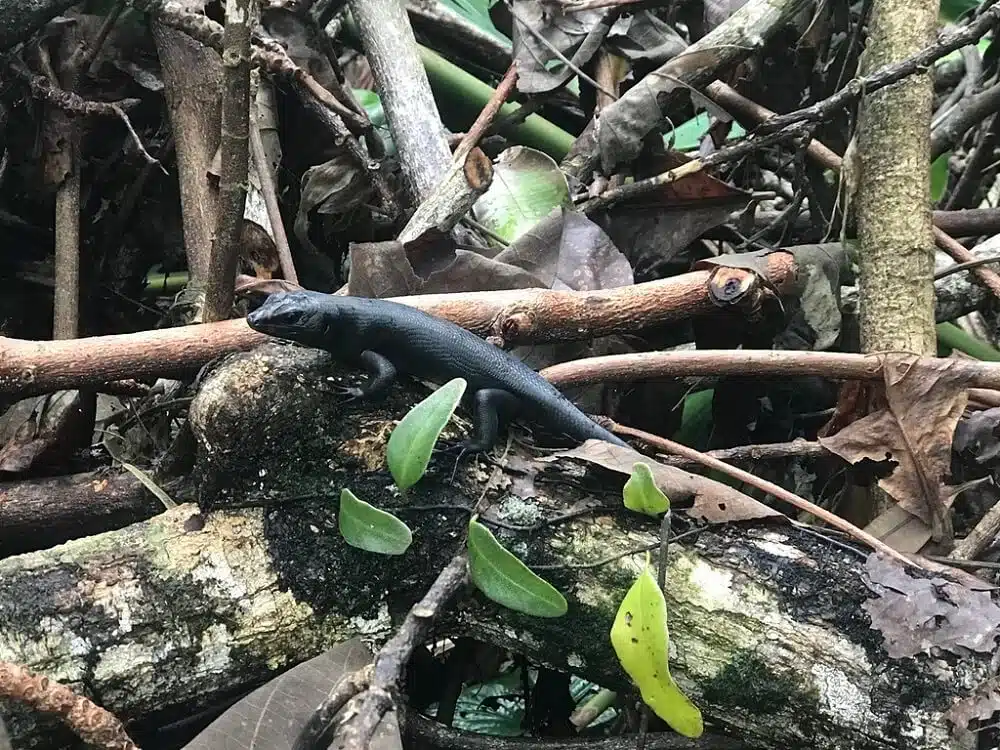The black color may dominate the appearance of some lizards.
Some of the rarest types of world lizards are black. From forests to remote islands, these lizards live in different habitats.
The following list also includes one surprise black lizard that lives in a marine environment.
Table of Contents
1. Black Girdled Lizard
An all-black color is characteristic of The Black Girdled Lizard (Cordylus niger). A species of The Table Mountain in South Africa, this lizard has a very restricted habitat.
Living on top of the mountain’s rocky formations, the lizard has a spiny appearance reminiscent of alligators.
Spiny rows on its head, legs, tail, and back may act as a warning sign to potential predators.

The size of the spines varies with age, as do its dark patterns.
Black Girdled Lizards are mostly black as adults but they can also be brown and black on cloudy days.
The dark appearance of Black Girdled Lizards allows these species to warm up in the sun while also absorbing the heat from the warm rocks it moves around during the day.
Common in – Cape Town, South Africa
2. Land Mullet

Land Mullets (Bellatorias major) are often black. Some brown variants also exist.
Its black variant shows all-black coloring on the head, body, tail, and legs. The skin of the lizard is smooth, unlike the skin of Black Girdled Lizards.
While much of their coloring is black, this is a species with a very bright and colorful underside. An orange-to-brown nuance is mostly characteristic of the species.
As Black Girdled Lizards, Land Mullets also take advantage of their dark appearance to absorb more heat from the sun.
These lizards spend much of their time in the open, in direct sunlight.
A species of woodlands, Land Mullets show diverse feeding habits. From mushrooms to insects, these lizards can eat almost anything they can find on the ground.
Common in – Tamborine Mountains, Australia
3. Black Rock Skink

A species of Australian beaches and woodlands, Black Rock Skinks (Egernia saxatilis) can be all-black.
A mix of large and small scales is seen on their smooth dorsum which is completely black.
Brown morphs of the species also exist and they can be as frequent as the black ones.
Spending much of its day hiding, the lizard can still be seen out in the sun, looking for food.
While a generalist feeder, The Black Rock Skink is mainly interested in insects. It finds them on rocks, in vegetation, and next to the beach.
Common in – Grampians National Park, Southeast Australia
4. Black Emo Skink

Black Emo Skins (Emoia nigra) are known for their very long thin tails and black coloring.
With an all-black appearance, the lizard has a smooth dorsum with a black head, legs, and tail.
Some of the more common morphs of the species include a blue morph and a green morph. These colored sheens are still based on base black coloring.
A blue-purple sheen to its black skin also represents a common variant of this ground lizard.
It can be found in woodlands where it prefers to hide in vegetation and dead leaves. Its dark appearance may make it difficult to spot.
In its young days, the lizard may even have a striped appearance with a large dorsal stripe of a bright brown color dominating its appearance.
Common in – Solomon Islands
5. Lace Monitor

Growing to a size of over 6 feet, Lace Monitors (Varanus varius) are among the larger black lizards in the world. An Australian native, this large lizard is dominated by black with additional yellow stripes.
Despite their large size, Lace Monitors are agile and arboreal. They spend most of their lives climbing or even up on trees.
Their capacity to climb is impressive. These types of lizards can even climb vertical surfaces with little grip.
Lace Monitors are similar and sometimes confused with large lizards such as The Komodo Dragon.
These lizards aren’t known for their movements in their habitat as they can live on the same tree for a long time.
A carrion eater, Lace Monitors feed on dead insects and animals.
Lace Monitors are among the few Australian lizards to be venomous.
Their bites may not kill people but Lace Monitors may still have venom of a potency similar to those of venomous snakes.
Common in – Southeastern Australia
6. King’s Skink

A mostly black appearance with yellow stripes and dots is characteristic of King’s Skinks (Egernia kingii). Named after the first explorer in the region of Western Australia, King’s Skinks are a common sight in vegetation.
This type of skink may reach a maximum size of just over 20 inches and is characterized by a thick body.
Its legs, dorsum, head, and tail, are black.
Black morphs with white or gray dots are also specific to this species which can live in woodlands, shrubland, and wetlands, on the coast.
King’s Skinks spend their time looking for food such as viable vegetation. Rarely, they may consider insects and other types of animal-based foods.
The black lizard may also be spotted perched on rocks either in Southwestern continental Australia or the small islands in the region.
Common in – Rottnest Island, Australia
7. Roughneck Monitor

A mostly black color is specific to The Roughneck Monitor (Varanus rudicollis), a Southeast Asian species.
An elongated mouth and a large size of up to several feet help identify this species. Roughneck Monitors get their names from the excess skin behind their heads.
An arboreal species, Roughneck Monitors live their lives up on tree branches where they sleep and eat.
Some of their typical foods include insects and frogs, the types of foods that come into its range.
Black color is specific to Roughneck Monitors. These lizards may also come in other colors, such as shades of gray and brown.
While seen in zoos and captivity, Roughneck Monitors don’t move much during the day and may not be as spectacular to look at as other lizards.
Common in – Thailand, Burma
8. Black Tree Monitor

Black or charcoal-black colors are specific to these types of arboreal lizards (Varanus beccarii).
A New Guinean native, Black Tree Monitors have a distinct appearance and clear distinctive habits.
A fussy lizard in captivity, Black Tree Monitors have a long tail. Their tails are so long they are a few times longer than their bodies.
Black Tree Monitors rely on their tails to balance their movements up on trees.
Living their long lives on branches, these lizards whip their tails for movement balance.
Lizards of this species are considered very good at balancing their movements with the help of their tails as they move on branches.
They need to move to catch prey with insects being one of their favorites.
Rarely seen on the ground, Black Tree Monitors are types of lizards that even breed up on trees. Males seek out females on branches and prefer not to come dome for breeding.
Common in – Aru Islands, New Guinea
9. Leopard Gecko – Black Night Morph

Leopard Geckos are types of lizards named after their black leopard-like spots across the dorsum.
The head and tail of these geckos are all-black. Its triangular head stands out as its wider than the body while the tail is mostly black and partly gray, towards the body.
The dorsum of this species is dark gray with black spots.
A type of hybrid very popular in captivity, Leopard Geckos are rare and expensive in the pet trade.
Under its different variants, which are often bright, Leopard Geckos can still be found in the wilderness.
Its range includes India, Nepal, and Pakistan. It can be found in arid areas of these countries, grassland, and even in desert-like climates.
A species with a varied diet, Leopard Geckos can eat all types of small animals. These types of geckos may even eat their young in the absence of more feasible young rodents or young reptiles.
Since this type of gecko is mostly seen as a pet reptile, its diet is somewhat different.
Grown in a large tank, the gecko is most fed insects and larvae.
Common in – Northwest India
10. Blue Tongue Skink – Melanistic Morph

A jet-black color is specific to the Blue Tongue Skin under its Melanistic Morph. This species is a native Australian and black is its rare morph.
Uniform black coloring may also make the Melanistic Morph an interesting choice for lizard pet lovers.
Melanism isn’t solely specific to Blue Tongue Skinks. This is a trait also seen in other lizards.
It can be explained as an atypical or abnormal high production of melanin. This is where a species, in this case, Blue Tongue Skinks, darkens partially or completely.
This lizard darkens to an all-black appearance on occasion.
However, its other rare trait, the blue tongue, doesn’t darken. As its name implies, this is a species that shows a contrasting blue tongue.
Most of its morphs maintain this blue tongue, visible when eating.
The skink can be found in some remote areas of Australia and islands around the country.
Common in – Australia, Indonesia
11. Fiordland Skink

A rare black species once eradicated, Fiordland Skinks (Oligosoma acrinasum) are among the black lizards that are seen in New Zealand today.
This is a species with an all-black color that may also feature a black and yellow-brown morph.
Found only in New Zealand, the species was saved when it was introduced outside of its habitat where it managed to recolonize a new area.
Fiordland Skinks like to live in forests where they are active during the day.
Common in – South Island, New Zealand
12. Marine Iguana

An Ecuadorian species of various colors, including black, Marine Iguanas (Amblyrhynchus cristatus) are among the atypical black lizards of the world.
These are the only types of lizards that feed in the sea. They dive for algae, which forms the bulk of their diet.
Marine Iguanas are also the sole worldwide iguanas to live in the sea where they dive (at low depths) for algae.
Their swimming capacity is unique, as are their colored patterns which depend on their species. This crested lizard also comes in black.
Common in – Ecuador